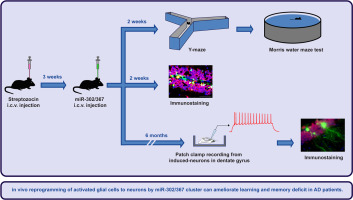Molecular and Cellular Neuroscience ( IF 2.6 ) Pub Date : 2017-11-24 , DOI: 10.1016/j.mcn.2017.11.012 Maryam Ghasemi-Kasman , Amir Shojaei , Mohammad Gol , Ali Akbar Moghadamnia , Hossein Baharvand , Mohammad Javan

|
In vivo reprogramming of reactive glial cells to neurons has opened a new horizon in regenerative medicine. Our previous study showed that astrocytes could be converted to neurons by the microRNA-302/367 (miR-302/367) cluster in adult brains. In this study, we investigated the possible contribution of miR-302/367-induced neurons in behavioral improvement and neural repair in an Alzheimer's disease (AD) animal model. The AD model was induced by an intracerebroventricular (i.c.v) injection of streptozotocin (STZ). GFP-only or miR-302/367 + GFP expressing lentiviral particles were injected into the dentate gyrus of the hippocampus along with intraperitoneal (i.p) valproate (VPA) injection, 3 weeks after the STZ administration. We assessed short-term and spatial memories by the Y-maze and Morris water maze (MWM) tasks, respectively. Electrophysiological activities of induced neuron-like cells were investigated using a whole-cell patch clamp technique, 6 months after injection of miR-302/367. Behavioral analysis showed that the STZ injection significantly impaired short-term memory and increased escape latency parameter in the MWM task. Compared to STZ and STZ + VPA groups, miR-302/367 combined with VPA significantly improved the spontaneous alternation and spatial memory. Immunostaining against NeuN, as a mature neuronal marker, and its quantification indicated that co-labeled GFP and NeuN significantly increased in the miR-302/367 + VPA group. Induced neurons were detected 6 months after the miR-302/367 injection. The patch-clamp recording suggested that induced neurons could fire repetitive action potential like endogenous neurons. In conclusion, our results indicated that in vivo reprogramming of reactive astrocytes to neurons by the miR-302/367 cluster might be considered as a novel strategy to restore learning and memory in AD patients.










































 京公网安备 11010802027423号
京公网安备 11010802027423号